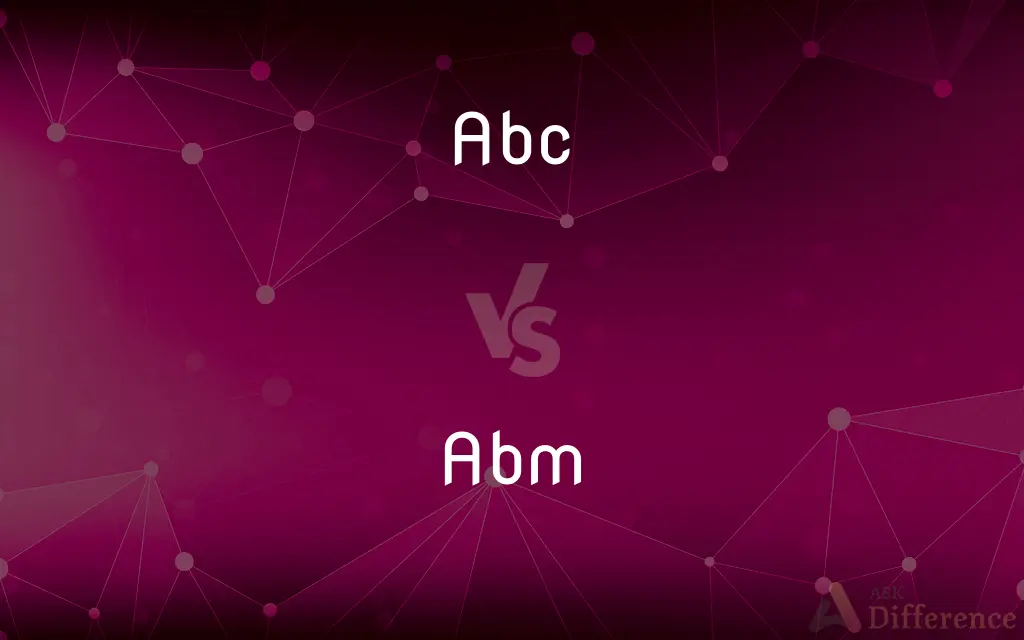ABC vs. ABM — What's the Difference?
Edited by Tayyaba Rehman — By Maham Liaqat — Updated on April 26, 2024
ABC (Activity-Based Costing) focuses on accurate cost measurement by allocating overhead costs based on activities, while ABM (Activity-Based Management) uses the insights from ABC to improve efficiency and effectiveness in business processes.

Difference Between ABC and ABM
Table of Contents
ADVERTISEMENT
Key Differences
ABC, or Activity-Based Costing, is a method used in accounting and management to more accurately allocate costs to products or services based on the activities that consume resources. This contrasts with traditional costing methods, which may allocate overhead or indirect costs less precisely. On the other hand, ABM, or Activity-Based Management, is an approach to management that uses the data and insights provided by ABC to identify wasteful or inefficient activities and to improve decision making across the organization.
ABC breaks down the indirect costs of production, helping to provide a more nuanced view of how resources are actually used in producing a product or delivering a service. This allows companies to more accurately price their products or services based on actual costs. Whereas, ABM takes this a step further by analyzing these costs to streamline operations, reduce waste, and enhance business processes based on activity performance.
The primary aim of ABC is to provide a detailed financial accounting that helps management see the true cost of carrying out business activities. This clarity can lead to better pricing strategies and product line decisions. In contrast, the goal of ABM is operational—using ABC data to support continuous improvement in processes and to reduce costs without sacrificing quality.
ABC can be seen as the foundation for ABM. Without the detailed cost information provided by ABC, ABM efforts might lack the necessary precision for targeted improvements. Meanwhile, ABM provides a strategic dimension to the numerical insights offered by ABC, focusing on how these can be leveraged for better performance and competitive advantage.
ABC is a powerful tool for cost management, its effectiveness increases significantly when used as part of an ABM strategy. ABM relies on the data from ABC to guide strategic decisions, such as which products to focus on or which processes to optimize or eliminate.
ADVERTISEMENT
Comparison Chart
Focus
Allocation of costs based on activities
Management of business activities for efficiency and effectiveness
Primary Objective
Accurate measurement of product/service costs
Improvement of business processes and decision-making
Scope
Mainly accounting and costing
Broader managerial and operational focus
Dependency
Self-contained approach to costing
Depends on data from ABC
Outcome
Precise costing data
Operational improvements and cost reduction
Compare with Definitions
Abc
Focuses strictly on the financial tracking and reporting of costs.
The financial team used ABC to provide detailed reports on the cost contributions of different company activities.
Abm
An approach to management that aims to increase the value and efficiency of business processes based on activity-based costing information.
ABM initiatives led to the redesign of workflows to cut down on non-value-added activities.
Abc
A costing method that identifies activities in an organization and assigns the cost of each activity to all products and services according to the actual consumption.
ABC was used to determine the true cost of manufacturing each widget, considering specific tasks like machining, assembly, and testing.
Abm
Can lead to strategic decisions such as product redesign, pricing adjustments, and customer profitability analysis.
ABM analysis showed that redesigning certain products could make them cheaper to produce without compromising quality.
Abc
Enhances the reliability of cost data, making it a valuable tool for decision-making.
ABC data helped the management to revise their pricing strategy based on the true costs uncovered.
Abm
Focuses on using ABC data to make operational improvements.
Using insights from ABC, the company implemented ABM strategies to reduce waste in their supply chain.
Abc
Suitable for complex environments where product lines are diverse.
In a multi-product company, ABC helped allocate overhead costs more accurately compared to traditional costing methods.
Abm
Helps in identifying inefficient processes and allocating resources more effectively.
ABM was applied to streamline the logistics process, significantly reducing delivery times and costs.
Abc
Aims to eliminate distorted product costs by accurately tracing costs to activities.
By implementing ABC, the company could see that their high-volume products were less profitable than previously thought due to indirect costs.
Abm
Often leads to continuous improvement in processes.
Ongoing ABM efforts resulted in regular updates to manufacturing processes, continuously enhancing efficiency and reducing costs.
Abc
The alphabet
Learned her ABCs when she was three years old.
Abm
A defensive missile designed to shoot down incoming intercontinental ballistic missiles;
The Strategic Arms Limitation Talks placed limits on the deployment of ABMs
Abc
The rudiments of reading and writing.
Abc
The rudiments of a subject
Taught the ABCs of geometry.
Abc
The elementary stages of any subject (usually plural);
He mastered only the rudiments of geometry
Common Curiosities
How do ABC and ABM contribute to competitive advantage?
By accurately costing products and improving processes, companies can better price their offerings and operate more efficiently, gaining a competitive edge in the market.
What is the main difference between ABC and ABM?
ABC is a methodology for assigning costs to activities, while ABM uses this information to manage and improve business activities.
What types of companies benefit most from ABC and ABM?
Companies with diverse products or services and significant indirect costs, such as manufacturing firms, benefit greatly from both ABC and ABM.
What challenges might a company face when implementing ABC and ABM?
Implementing ABC and ABM can be resource-intensive and may require significant changes in internal processes and systems.
Can a company use ABM without implementing ABC?
While ABM can be informed by other types of data, it is most effective when based on the precise, activity-focused costing data provided by ABC.
How do ABC and ABM help in pricing decisions?
ABC helps in accurately costing products, which can inform more strategic pricing decisions. ABM can further refine these decisions by identifying cost-saving opportunities through process improvements.
Can ABC and ABM be applied to small businesses?
Yes, while more commonly used in larger organizations, small businesses can also benefit from the detailed insights provided by ABC and the operational improvements driven by ABM, especially in competitive markets.
How does ABC support ABM?
ABC provides the detailed cost information necessary for ABM to identify and act on operational inefficiencies and opportunities.
Is ABM relevant for service industries?
Yes, ABM is quite relevant in service industries where efficiency in process management can lead to significant cost savings and improved customer satisfaction.
What are the benefits of integrating ABC with ABM?
Integrating ABC with ABM allows organizations to not only track costs accurately but also to use these insights to drive meaningful changes and improvements in business operations.
Share Your Discovery

Previous Comparison
Chore vs. Line
Next Comparison
Consenter vs. ConsentedAuthor Spotlight
Written by
Maham LiaqatEdited by
Tayyaba RehmanTayyaba Rehman is a distinguished writer, currently serving as a primary contributor to askdifference.com. As a researcher in semantics and etymology, Tayyaba's passion for the complexity of languages and their distinctions has found a perfect home on the platform. Tayyaba delves into the intricacies of language, distinguishing between commonly confused words and phrases, thereby providing clarity for readers worldwide.














































